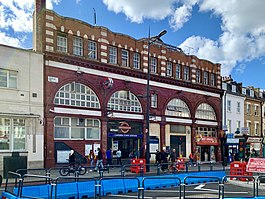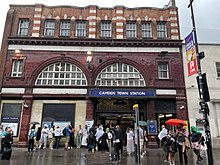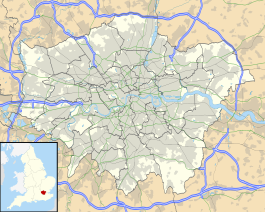This article needs additional citations for verification. (November 2012) |
Camden Town is a London Underground station in Camden Town.[7] It is a major junction for the Northern line, as it is where the Edgware and High Barnet branches merge from the north, and is also where they split to the south into the Bank and Charing Cross branches for the journey through Central London. It is particularly busy with visitors to the Camden markets at weekends, and, until 2019, was exit-only on Sundays to prevent overcrowding.
| Camden Town | |
|---|---|
 | |
| Location | Camden Town |
| Local authority | London Borough of Camden |
| Managed by | London Underground |
| Number of platforms | 4 |
| Fare zone | 2 |
| OSI | Camden Road |
| London Underground annual entry and exit | |
| 2019 | |
| 2020 | |
| 2021 | |
| 2022 | |
| 2023 | |
| Railway companies | |
| Original company | Charing Cross, Euston and Hampstead Railway |
| Key dates | |
| 22 June 1907 | Station opened |
| 20 April 1924 | Link from Euston (C&SLR) opened |
| Other information | |
| External links | |
| Coordinates | 51°32′22″N 0°08′34″W / 51.5394°N 0.1427°W |

Northbound, the next stations are Chalk Farm on the Edgware branch and Kentish Town on the High Barnet branch. Southbound, the next stations are Euston on the Bank branch and Mornington Crescent on the Charing Cross branch. The station is in Travelcard Zone 2.
History
editCharing Cross, Euston and Hampstead Railway
editThe station was first proposed as part of the original route of the Charing Cross, Euston and Hampstead Railway (CCE&HR) (now part of the Northern line). Proposals for the line had existed since 1893, but construction did not begin until the American entrepreneur Charles Tyson Yerkes invested in the line in October 1900. Work started in July 1902, and the station was opened on 22 June 1907 by David Lloyd George, then President of the Board of Trade.[8] The line here branched into two routes, to Hampstead and to Highgate. The line to Hampstead (now the Edgware branch) is under Chalk Farm Road; the line to Highgate (now the High Barnet branch) is under Kentish Town Road. With the narrowness of the roads above, and the necessity to keep directly beneath them to avoid having to pay compensation to landowners during construction, on both branches the northbound platform is directly above the southbound one. The two roads meet at an angle of 35° forcing the station into an unusual V shape. The surface building was designed by the Underground Electric Railways Company of London's (UERL's) architect Leslie Green.[9]
At the apex of the V was a junction allowing northbound trains to take either of the branches north, and likewise allow the trains south from the branches to join the single southbound track under Camden High Street. This resulted in four connecting tunnels. When the CCE&HR and City & South London Railway (C&SLR) lines were joined together after the C&SLR became part of the Underground Group on 1 January 1913,[10] a short extension was planned from the Euston terminus of the City & South London Railway to connect with the CCE&HR south of Camden Town station allowing services to run from both City and West End branches to and from the Hampstead and Highgate branches.[11] City branch services were extended to this station on 20 April 1924.[12] The work required to join the two lines together at Camden Town was one of the most ambitious projects in the history of the Underground, and was undertaken without disrupting any existing services.[13] It added another four tunnels that allows trains to proceed to or from either the Edgware or High Barnet branch on to or off both the City or Charing Cross branch without following conflicting paths.[14] The multiple junction tunnels are effectively located beneath Camden High Street.
The original lifts and emergency stairs to the platforms were inside the vertex of the V, leading to four passageways, one to each of the platforms, with return passageways back to the lifts. With growing patronage and increasing congestion the lifts were later replaced by escalators that came into service on 7 October 1929 with an escalator heading from the station building to a circulating area at the northern end of the platforms.[12] This has only two pairs of parallel passageways, one for each branch (northbound), with a small side passage on each leading to the lower southbound platforms. One set of the original lift passageways became part of the ventilation system, but the remaining one adds to the confusion of the station.
Northern line
editThe line, known post-merger for many years as the 'Edgware - Morden' line, was formally referred to as the Northern line from 28 August 1937.[15]
The station was damaged by a bomb on 14 October 1940 during the Blitz. One person was killed.[16] Shortly afterwards, Camden Town was chosen as one of eight stations on the Northern line where dedicated air-raid shelters would be constructed alongside the line, capable of accommodating 640,000 people.[17]
2003 derailment
editOn 19 October 2003, the last carriage of a 1995 stock train derailed on the approach to the station while traversing points in the connecting tunnels that connect the various Northern line branches. Seven passengers were injured, six of them with minor injuries. Two carriages were seriously damaged by the impact.[18][19] After the accident, trains were restricted to travelling either from the Edgware branch to the Bank branch or from the High Barnet branch to the Charing Cross branch. Full use of the junction was restored in March 2004.
Following the derailment, a joint report by London Underground and its maintenance contractor Tube Lines concluded that poor track geometry was the main cause of the derailment. Extra friction arising out of striations (scratches) on a newly installed set of points had allowed the leading wheel of the last carriage to climb the rail and therefore derail. The track at the derailment site is on a very tight bend in a tight tunnel bore, which prevents canting the track by dipping the height of one rail relative to the other, the normal solution in this sort of situation.[20]
Future expansion and upgrade
editThe station is too small for current passenger demand, with just two escalators and too few passageways between Northern line platforms.[21] The station is particularly busy at weekends with tourists visiting Camden Market and Camden High Street, with entry to the station prohibited on Sunday afternoons to prevent overcrowding on the station's narrow platforms. By 2021, weekday passenger demand at the station is expected to grow by 40 per cent.[21]
London Underground originally submitted redevelopment plans in the early 2000s, a £130m project that would have eased congestion and provided step free access – with residential and office development above the new station.[22] However, the project involved demolition of all buildings between Buck Street, Camden High Street and Kentish Town Road – including Buck Street Market, Electric Ballroom and the ox-blood tiled Leslie Green station building itself.[22] London Underground's reasoning was that land was required for a temporary entrance for the station while the new station was built.[23] Complaints regarding the loss of these buildings and the market[23] – as well as complaints regarding out-of-place and out-of-scale development when compared to the remainder of Camden Town – led to a public inquiry, which was held in 2004.[23] In 2005, Transport for London had their Transport and Works Act order refused by the office of the Deputy Prime Minister[24][25][26] and the scheme was subsequently cancelled.
In 2013, TfL announced[27] new redevelopment plans given the continuing congestion and high passenger demand at the station.[21][28] Instead of the previously aborted scheme, TfL proposed a new station building built on the north side of Buck Street, on the site of the vacated Hawley School, avoiding the need to demolish both the original station and the other previously-threatened buildings.[29] As well as this new station entrance, expansion work would take place throughout the station with new escalators and passageways and step-free access - tripling the size of the station.[21] In the 2017 consultation, construction work was estimated to take four years to complete.[21] In 2018, following the delays to Crossrail and the knock on effects on TfL's business plan, the station upgrade was placed on hold indefinitely.[30]
Station layout
editTrack layout | ||||||||||||||||||||||||||||||||||||||||||||||||||||||||||||||||||||||||||||||||||||||||||||||||||
|---|---|---|---|---|---|---|---|---|---|---|---|---|---|---|---|---|---|---|---|---|---|---|---|---|---|---|---|---|---|---|---|---|---|---|---|---|---|---|---|---|---|---|---|---|---|---|---|---|---|---|---|---|---|---|---|---|---|---|---|---|---|---|---|---|---|---|---|---|---|---|---|---|---|---|---|---|---|---|---|---|---|---|---|---|---|---|---|---|---|---|---|---|---|---|---|---|---|---|
1907 to 1924
| ||||||||||||||||||||||||||||||||||||||||||||||||||||||||||||||||||||||||||||||||||||||||||||||||||
| ||||||||||||||||||||||||||||||||||||||||||||||||||||||||||||||||||||||||||||||||||||||||||||||||||
1924 to present
| ||||||||||||||||||||||||||||||||||||||||||||||||||||||||||||||||||||||||||||||||||||||||||||||||||
| ||||||||||||||||||||||||||||||||||||||||||||||||||||||||||||||||||||||||||||||||||||||||||||||||||
As one of only three stations where transfers between the Bank and Charing Cross branches are possible and the northern of the two junctions between them, Camden Town features a complex platform arrangement. Like its sister station of Kennington, the station has four platforms with cross-platform interchanges available between branches.
However, unlike at Kennington, since trains do not terminate at Camden Town there are no terminus platforms or loop to allow terminating trains to turn around. Instead, all northbound trains heading towards Edgware use platform 1 and those heading towards High Barnet or Mill Hill East use platform 3. Trains heading southbound to either central branch use platforms 2 if coming from Edgware and 4 if coming from High Barnet or Mill Hill East respectively.
Connections
editOut-of-station interchange
editCamden Road station is located 450 metres north-east of the station for London Overground services to Stratford, Hackney, Gospel Oak and Richmond.
Buses
editLondon Buses routes 1, 24, 27, 29, 31, 88, 134, 214, 253, 274 and night routes N5, N20, N27, N28, N29, N31, N253 and N279 serve the station. Route 46 passes nearby.
Air raid shelter
editCamden Town is one of eight London Underground stations with a deep-level air-raid shelter underneath it. The entrances are on Buck Street (near the market) and Underhill Street with the shelter tunnels reaching from just north of Hawley Crescent to south of Greenland Street.
Nearby places
editReferences
editCitations
- ^ "Out-of-Station Interchanges" (Microsoft Excel). Transport for London. 2 January 2016. Retrieved 28 August 2016.
- ^ "Station Usage Data" (XLSX). Usage Statistics for London Stations, 2019. Transport for London. 23 September 2020. Archived from the original on 9 November 2020. Retrieved 9 November 2020.
- ^ "Station Usage Data" (XLSX). Usage Statistics for London Stations, 2020. Transport for London. 16 April 2021. Retrieved 1 January 2022.
- ^ "Station Usage Data" (XLSX). Usage Statistics for London Stations, 2021. Transport for London. 12 July 2022. Retrieved 7 September 2022.
- ^ "Station Usage Data" (XLSX). Usage Statistics for London Stations, 2022. Transport for London. 4 October 2023. Retrieved 10 October 2023.
- ^ "Station Usage Data" (XLSX). Usage Statistics for London Stations, 2023. Transport for London. 8 August 2024. Retrieved 16 September 2024.
- ^ "Tube Map" (PDF). Transport for London. Retrieved 13 April 2015.
- ^ Day & Reed 2010, pp. 76–68.
- ^ Day & Reed 2010, p. 77.
- ^ Jackson & Croome 1993, p. 122.
- ^ Follenfant 1975, pp. 16–17.
- ^ a b Leboff 1994, p. 28.
- ^ Day & Reed 2010, p. 94.
- ^ Jackson & Croome 1993, p. 144.
- ^ Jackson & Croome 1993, p. 228.
- ^ Day & Reed 2010, p. 136.
- ^ Day & Reed 2010, p. 143.
- ^ "Second Tube train derailed". BBC News. 19 October 2003. Retrieved 25 July 2020.
- ^ "Seven hurt in Tube derailment". The Daily Telegraph. 19 October 2003. ISSN 0307-1235. Retrieved 25 July 2020.
- ^ Kitching, Rubina (4 December 2003). "Track design flaws may have led to Camden Town Tube derailment". New Civil Engineer. Retrieved 25 July 2020.
- ^ a b c d e "Improving capacity at Camden Town station". Transport for London. 2017. Archived from the original on 21 February 2018. Retrieved 20 February 2018. Detailed report, with updated timeline etc.
- ^ a b "Camden Town Redevelopment". alwaystouchout. Archived from the original on 11 November 2007. Retrieved 21 November 2007.
- ^ a b c "Inquiry begins into market plans". BBC News. 10 February 2004. Retrieved 26 January 2020.
- ^ "London Underground (Camden Town Station) Order". Department for Transport. 16 February 2006. Archived from the original on 16 February 2006. Retrieved 26 January 2020.
- ^ "Station plan refusal saves market". BBC News. 21 June 2005. Retrieved 26 January 2020.
- ^ "Camden Town Station proposed redevelopment - Transport for London". Transport for London. 10 September 2006. Archived from the original on 10 September 2006. Retrieved 26 January 2020.
- ^ "New upgrade plan for Camden Town underground station unveiled". Camden New Journal. 13 September 2013. Archived from the original on 23 September 2015. Retrieved 13 April 2015.
- ^ "We Need To Talk About Camden: The Future of the Northern Line". London Reconnections. 6 May 2013. Retrieved 13 April 2015.
- ^ "Have your say on a development above the proposed new second entrance for Camden Town Underground station on Buck Street". Transport for London. 16 February 2018. Retrieved 20 February 2018.
- ^ Topham, Gwyn (11 December 2018). "Major tube upgrades shelved as TfL struggles to balance books". The Guardian. ISSN 0261-3077. Retrieved 26 January 2020.
Sources
- Day, John R; Reed, John (2010) [1963]. The Story of London's Underground. Capital Transport. ISBN 978-1-85414-341-9.
- Follenfant, H.G. (1975). Reconstructing London's Underground; H G Follenfant (2nd ed.). London Transport.
- Jackson, Alan; Croome, Desmond (1993) [1964]. Rails Through the Clay: A History of London's Tube Railways (2nd ed.). Routledge.
- Leboff, David (1994). London Underground Stations. Ian Allan. ISBN 978-0-711-02226-3.
External links
edit- Subterranea Britannica's visit to the Camden Town deep level shelter
- London Transport Museum Photographic Archive
- Station building in 1937, Chalk Farm Road elevation. Utilitarian building is London Underground electrical substation.
- Bomb Damage in October 1940. The elevation was never fully rebuilt.
| Preceding station | London Underground | Following station | ||
|---|---|---|---|---|
| Kentish Town High Barnet branch towards Mill Hill East or High Barnet
|
Northern line | Euston Bank branch
| ||
| Chalk Farm Edgware branch towards Edgware
|
Mornington Crescent Charing Cross branch
| |||
| Out of system interchange | ||||
| Preceding station | London Overground | Following station | ||
| Kentish Town West towards Richmond or Clapham Junction
|
Mildmay line North London line transfer at Camden Road
|
Caledonian Road & Barnsbury towards Stratford
| ||
| Former Route | ||||
| Preceding station | London Underground | Following station | ||
| South Kentish Town towards Highgate
|
Northern line (1907–1923)
|
Mornington Crescent towards Charing Cross
| ||
| Chalk Farm towards Golders Green
| ||||
